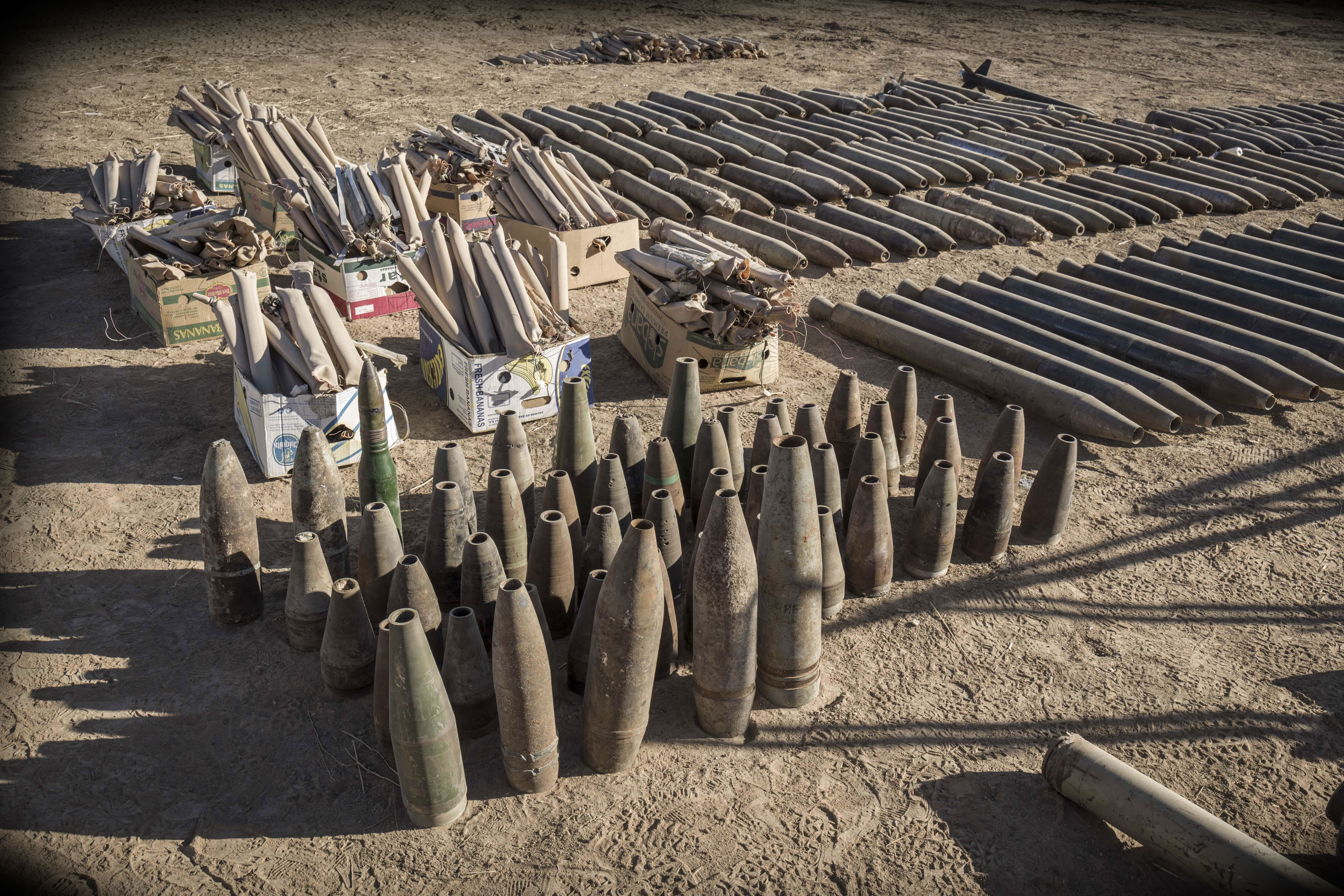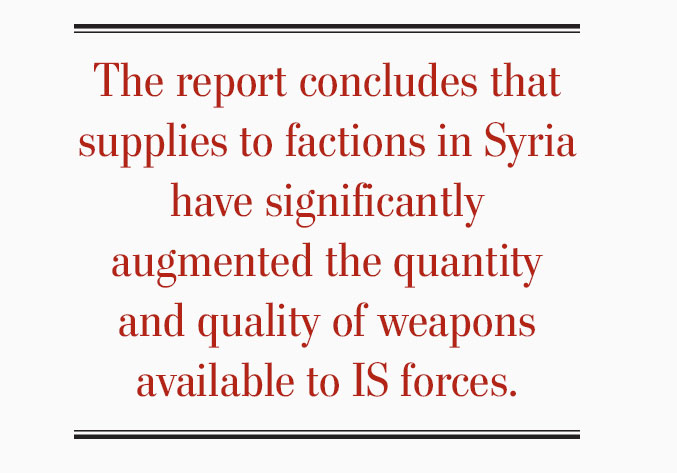
IS weapons recovered in Iraq in November 2016. [Berci Feher/ZUMA Wire/Alamy Live News]
Funded by the European Union (EU) and the German Federal Foreign Office, Conflict Armament Research deployed investigative teams across front-line positions of IS between July 2014 and November 2017.
In what the organization describes as “unquestionably the most comprehensive, verified study” of IS weapons to date, it analyzed more than 40,000 items recovered from IS forces between 2014 and 2017.
The group’s 201-page report, released in December, says 97 per cent of IS weapons and 87 per cent of its ammunition are of Warsaw Pact calibres. The balance are NATO-calibre, captured during initial assaults on Iraqi forces in 2014.
It determined that most of the materiel fell into IS hands through unauthorized transfer—or violations of agreements by which supplier governments prohibit the re-export of materiel by a recipient government without prior consent.
“The United States and Saudi Arabia supplied most of this materiel without authorisation, apparently to Syrian opposition forces,” says the report. “This diverted materiel, recovered from IS forces, comprises exclusively Warsaw Pact-calibre weapons and ammunition, purchased by the United States and Saudi Arabia from European Union Member States in Eastern Europe.”
It says many of the items originated in shipments that run into the thousands and include weapons, ammunition and “the traceable components and chemical precursors used by IS forces to manufacture improvised explosive devices (IEDs).”

Formed in 2011, Conflict Armament Research investigates weapons supplies to conflict zones in efforts to improve their management and control.
It says governments and producer companies co-operated with its IS investigation, allowing it to trace items to “precise lines of supply that brought them from the place of manufacture to the conflicts raging in Iraq and Syria.”
Some of the report’s data is already forming the basis of criminal proceedings, including investigations by Belgian police into supplies of IED components.
It found the most rapid case of diversion following an unauthorised re-transfer involved an advanced anti-tank guided weapon manufactured in the EU, sold to the United States and supplied to a party in the Syrian conflict. It was transferred to IS forces in Iraq within two months of leaving the factory.
“Supplies of materiel into the Syrian conflict from foreign parties—notably the United States and Saudi Arabia—have indirectly allowed IS to obtain substantial quantities of anti-armour ammunition,” says the report.
“These weapons include [anti-tank weapons] and several varieties of rocket with tandem warheads, which are designed to defeat modern reactive armour. These systems continue to pose a significant threat” to coalition troops fighting IS.
Together, Russia and China manufactured more than half the IS weapons and ammunition, while former Warsaw Pact countries, now EU members, made more than 30 per cent of the remaining weapons and 20 per cent of the ammunition.
The report concludes that supplies to factions in Syria have significantly augmented the quantity and quality of weapons available to IS forces—“in numbers far beyond those that would have been available to the group through battlefield capture alone.”
The report acknowledges that the large-scale capture of weapons by IS forces from units of Iraqi defence and security forces, notably in 2014, is well documented.
“However, the fact that the group has rapidly acquired (often within the space of months) weapons supplied by a range of extra-regional states is less well recognised. In particular, the impact of the group’s acquisition of anti-armour weapons on its operational capacity is difficult to quantify, but these weapons continue to pose a significant threat to coalition armoured forces.”
The report says its findings are “a stark reminder of the contradictions inherent in supplying weapons into armed conflicts in which multiple competing and overlapping non-state armed groups operate.”
“Under such circumstances, it is difficult to exert effective control over which groups ultimately gain custody of weapons.”
Some of the report’s other findings:
- Overall, China produced most of the materiel fielded by IS. But Russian-manufactured weapons outnumbered Chinese weapons deployed by IS forces in Syria, presumably reflecting Russian supplies to the Syrian regime.
- Almost half (845) of documented weapons have serial numbers close in sequence to those of other, identical weapons in the sample. They can be grouped into 240 sets manufactured in the same production runs and probably exported in the same, or successive, batches.
- In contrast to weapons, IS ammunition tends to be of recent manufacture. Fewer than two per cent of weapons were made since 2010. Yet more than 15 per cent of the group’s ammunition was produced and supplied after the Syrian conflict started. “These findings underscore the pivotal role that supplies of newly produced—and recently diverted—ammunition play in sustaining armed insurgency and terrorism worldwide.”
- Nearly 40 per cent of all 40mm and 73mm anti-armour rockets deployed by IS forces in Iraq were produced in the past four years, when the group became a significant component of the Iraq and Syria conflicts. EU members produced 40 per cent of rockets manufactured since 2010.
- Parties attempted to conceal the provenance of much of the IS materiel by removing ammunition from its original boxes and repacking it, and obliterating factory marks by overpainting or abrasion, despite the fact neither Iraq nor Syria is subject to UN arms embargoes.
- Materiel also originates in other conflict-affected regions or match materiel that has been diverted to those regions, including Libyan national weapons stockpiles; East European ammunition from Somalia via the United States; and weapons previously identified in South Sudan.

“Turkish territory is the main—although not exclusive—source of chemical explosive precursors (ammonium nitrate, potassium nitrate, aluminium paste and sorbitol), detonating cord, detonators, containers used to house IED main charges, and ancillary IED components employed by IS forces.”
Investigators say they identified specific parties responsible for purchasing these components on the Turkish market and for supplying a range of opposition forces in northern Syria, including Salafist jihadist factions.
“Many of these precursors are either manufactured by the same factory, or supplied by the same distributor. IS forces procured them in bulk and, in some cases, they sourced different precursors around the same time. Such bulk buying from a single source is likely to be highly visible in commercial sales records.”
Investigators documented large quantities of other components that had been procured on different dates spanning long periods from the same source. “This indicates that IS forces have a robust supply chain, whereby the group can repeatedly procure chemicals from the same supplier.”
Iraqi Security Forces, the Peshmerga in Iraq’s Kurdistan Region and the Kurdish People’s Protection Units in Syria provided field investigators with complete access to front-line positions, allowed full evidence recovery from weapons-seizure sites and captured IS weapons production facilities. They also protected the teams.
None of the manufacturer or their respective governments acted unlawfully, says the report. “Their cooperation…is an indicator of the strength of their domestic and international commitments to curb the supply of weapons and associated materiel to unauthorised users.”
“At the very least, the diversion of weapons documented in this report has eroded the trust that exporting authorities placed in the recipient governments,” it says. “At worst, the diversions occurred in violation of signed agreements that commit recipient governments not to re-transfer materiel without the exporter’s prior consent.”
Advertisement



















